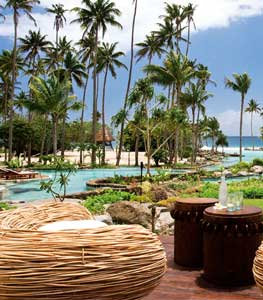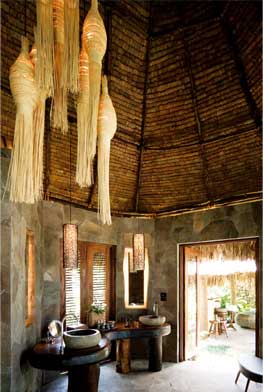I am not rich or famous, but my job as a travel writer has allowed me to pretend I am both. Over the last 10 years, I have traveled the globe, stopping briefly at some of the most spectacular properties in the world. But nothing prepared me for a four-day plunge into complete hedonism at Laucala Island in the Fiji Islands.
The lush, 3,000-acre island once belonged to the late publishing magnate Malcolm Forbes. In 2002, another wealthy recluse, Australian Dietrich Mateschitz, the co-founder of Red Bull energy drink, purchased the property and spent three years converting it into a self-sufficient luxury hideaway. When Mateschitz isn’t in residence, his digs, depending on the number of guests and private chefs in tote, rent for $26,000 to $35,000 a night. If you’d rather it not be known that you’re spending that kind of dough, the staff and full-time security force make sure no names are leaked. The Schwarzenegger family, John Travolta, and Oprah Winfrey are the only high-profile guests who have publicly flaunted their vacations at Laucala Island. Winfrey recently stayed in Mateschitz’s house, a stunning hilltop split-level number with two pools and 360-degree panoramic views of the surrounding islands and azure sea.

There are only two ways to reach Laucala Island: arrange a pickup by the retreat’s seven-seat Beechcraft King Air turboprop at Nadi International Airport on the island of Viti Levu, or charter a boat. That is, unless you’ll be arriving on your own plane or yacht. We took the 45-minute flight from Nadi. After the pilot opened the doors, we were greeted by the entire staff, property managers Maja and Thomas Kilgore, and their Rhodesian Ridgeback, Treu. The group of about 50 burst into a traditional Fijian welcome song, followed by ice-cold towels and a glass of fresh juice.
THE ISLAND: As we drove from the airstrip through the dense tropical forest, we weren’t immediately aware that we’d arrived in a fantasy playground. Then the car shot into an open coconut plantation where hundreds of swaying coconut palms are surrounded by banana, guava, papaya, and soursop trees. Looking closer, we noticed many varieties of wild orchids and crocus, and thick walls of red, yellow, and gold hibiscus bushes. At one point, we were encircled by tall volcanic peaks with rocky tips. Minutes later we traversed a valley where reef herons poked around in small ponds filled with lily pads topped with purple blooms. We felt like we were in a scene of Jurassic Park, not a luxury resort. Then we slowed to view a stunning maze of multilevel pools and sandy-bottom lagoons. A thatched-roof bar with low, bird’s-nest-shaped chairs overlooked a deep lap pool with two sides built of stone and two of clear glass. The structure looked like a human aquarium. A lone swimmer ducked under the bridge in the road and continued to gently stroke his way to the end of the pool, which ends at the beach with sand so white that it looked like the staff had just bleached it.
VILLAS: Our next stop was our home on the beach. There are 25 residences (bures) scattered around the island, each with a unique design and view. The majority of the one-, two-, or three-bedroom spaces are located along the beach. Every bure has a private pool, dinner pavilion, sun deck, and yoga platform. You also have use of two golf carts to get around the island. The interior design of the villas is inspired by plants, leaves, ferns, pebbles, insects, and sea creatures. Chic, but Fijian in style, the furniture and lighting fixtures are works of art with a touch of whimsy.
Once the staff left, we explored our 2,500-square-foot bure like giddy school children. Each of the three major rooms in our residence was connected by wooden walkways covered by a thatched roof. There are no hard edges or straight lines, which creates a seamless transition from the indoor to the outdoor living spaces. We counted eight places to bathe. Each bedroom has an indoor and an outdoor bathroom with stone tubs and showers. The floor lamps in all of the rooms are shaped at the island’s craft village out of driftwood. There was a giant “jellyfish” chandelier made with local magi magi (coconut thread) tentacles that allowed hanging shell discs to float on the ceiling of my bedroom. When I opened my sliding door, the breeze twirled the shells, and the whole fixture appeared to swim across the room. The handmade shaggy rugs mimic coral reefs. Small accent lights resemble clusters of bird’s nests, silk cocoons, and sea grass. The center salon room, with cozy couches and a dining table, is also where we found the controls to the Bose speaker system next to iPods preloaded with music. There are two refrigerators. One was filled with vintage wine and Champagne; the other with soft drinks, bottled water, and several carafes of freshly squeezed juices that were replenished daily. As I marked off the 150 feet of our private shoreline, I switched my sights from the glistening South Pacific on my right to the volcanic cliffs on my left.

DINING: For the more formally inclined, Laucala Island offers Plantation House Restaurant, a colonial-style house with white tablecloths, a wine cellar, and a menu filled with contemporary haute cuisine. If you aren’t in the mood for a 10-course degustation menu paired with wine, you might prefer the dramatic views and tapas menu at the open-air Rock Lounge. The Seagrass Lounge and Restaurant, located on a cliff near the end of the residences, is virtually an amphitheater overlooking the neighboring islands. The sexy multilevel dining area has an elegant, contemporary Asian feel. The highlight meal of our visit took place in the Teppanyaki grill room set on a platform cantilevered over the rocky coast. The tiny space seats four, and from our perch we watched the waves hit the beach as the chef wielded her knives and spatulas across an iron griddle. The dining nook, surrounded by tropical plants, has to be the most romantic clandestine restaurant in the world. We also took several meals in the casual comfort of the Beach Bar located at the edge of the lagoon. For lunch, we enjoyed chilled gazpacho and crab salad. One evening, we basked in the light from glowing tiki torches and dipped our toes in the water as we feasted on paka paka fish wrapped in banana leaves and cooked on an outdoor grill. If you choose room service, don’t expect the staff to drop off your order. There is a prep kitchen hidden beside the bure, and your meal is served by course in your room.
PHILOSOPHY AND FOOD: The retreat’s philosophy is clear: the whole island is not a manicured resort. It’s a self-sustaining home with huge vegetable and herb gardens, livestock, and a staff that makes furniture, soap, oil, baskets, textiles, and art using only the resources of the island. The extensive farm is located on the east side of the island. Crops include tapioca, eggplant, sweet potatoes, coffee, cocoa, tea, pumpkins, lettuces, and potatoes. The variety of tropical fruits that grow wild include bananas, papaya, mangos, glass apples, star fruit, bread fruit, and bush limes. They raise cattle, a cross breed of Limousin and Hereford that has been bred on the island since the late 1800s. Wild goats, sheep, wild boar, domestic pigs, ducks, bush turkeys, and quail are just a few of the island’s resources for protein. Fresh water filters down through volcanic rock where it is drawn from underground caves and bottled in recycled glass bottles. Two exclusive coffees are blended on the island, and coconut milk is pressed around the clock for the kitchen and the production of spa products.

ACTIVITIES: I realized early it would be difficult for me to disengage my brain from electronic communication and the urge to plan every minute of the day. The beauty of Laucala is you don’t have to prearrange a single activity. Everything is available to you at any time. If you wake up from a nap and feel like going diving, get in your golf cart and head over to the dive shop. There will be an instructor, gear, and a boat ready to go. If you change your mind on the way to the dive shop, hang a right and head up to the 18-hole championship golf course designed by Scotsman David McLay Kidd. You won’t need anything. They have clothes, shoes, clubs, and balls with your name on them. Want to quit after nine holes and go for a trail ride on horseback? Just show up at the stables. There’s also deep-sea fishing, yoga, tennis, and 3 miles of hiking trails. If you’re a birder, you’ll be happy to check off the rare orange dove on your species list. (There is a mating pair that lives just beyond the Rock Lounge.)
SPA: Even the extensive spa at Laucala doesn’t exude a high-end resort vibe. The main room is hidden down a path that winds through running creeks, herb gardens, and a jungle of blossoming lotus flowers, heliconias, ginger, and anthuriums. Four spa suites are tucked into private areas and include a Vichy shower, bucket showers, and a steam area. Many of the treatments are designed around the Fijian belief in the healing powers of water. All of the products used in the treatments—soap, shampoo, oils, lotions—are made in the spa from ancient Fijian recipes. They harvest vanilla, cocoa, lemon grass, cinnamon, nutmeg, and coffee to blend scented oils.
I could have spent four days sampling the “detoxifying micro algae envelopment treatment” or the “volcanic ash clay body wrap,” but I didn’t have time. My four days were up. And even though I’d let go of my appointment-making addiction, my brief life of hedonism had ended. When we stood by the plane to take us back to Nadi, the staff returned to sing a traditional goodbye song. I actually broke down and cried. Sure, I would miss my beautiful bure on the beach, but I had pictures to remind me. What I couldn’t capture with my camera was the warm spirit of the Fijian people and the contagious peace of mind of Laucala Island. I wiped my tears, stepped on the plane, and flashed a “thumbs up.” Then I strapped myself in, took out my laptop, and grabbed a Red Bull.
HOW TO GET THERE: Air Pacific offers nonstop flights from Los Angeles to Nadi International Airport. Flights arrive early in the morning, making it easy to arrange a pickup by private plane for the 45-minute flight to Laucala Island.
RATES: All inclusive. $3,800-$35,000 per night. laucala.com
This article originally appeared in the September 2011 issue of D Magazine.






